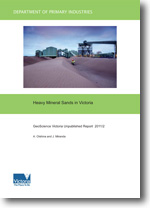GSV UR2011/2 - Heavy Mineral Sands in Victoria
 |
| |||||
Product description:Executive Summary The source of heavy mineral sands (HMS) in the Murray Basin is probably the weathered and eroded Palaeozoic and older rocks surrounding the basin. The HMS deposits in the Murray Basin formed within the Loxton-Parilla Sands during a Late Miocene-Pliocene regression. HMS accumulated in the near-shore environment of the Murray Basin sea, primarily as strandline deposits where HMS tend to concentrate in a near-shore, lowenergy zone where HMS become stranded due to their greater density; and WIM-style (offshore) deposits which formed in deeper water. The genesis of WIM-style deposits is still poorly understood. Southern Victoria is also host to numerous strandline deposits contemporaneous to those of the Murray Basin. These have a similar depositional character and occur within the Otway, Port Phillip and Gippsland Basins but are generally smaller in regional extent than those found in northwestern Victoria. Strandline deposits are characterised by their relatively linear geometry and WIM-style deposits by their sheet-like geometry. Strandline deposits tend to be coarse grained (>100 μm grain size), while WIM-style deposits tend to be fine grained (<100 μm grain size). Strandline deposits tend to be relatively rich, with grades in the range of 5-20% HMS, but are relatively low tonnage, while WIM-style deposits tend to have lower grades, in the range of 2-5% HMS, but tonnages that are at least one order of magnitude greater than that of strandline deposits. Download The downloadable version of this report is supplied in PDF format. Bibliographic Reference Olshina, A. & Miranda, J., 2011. Heavy Mineral Sands in Victoria. Geological Survey of Victoria Unpublished Report 2011/2. Department of Primary Industries. | ||||||

